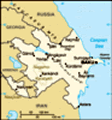Advertisement
Published: August 28th 2019
We left Baku for the Village of Lahij. On the way we visited the Juma Mosque in Shamakhy. It was built in 743 and severely damaged in the earthquakes of 1859 and 1902. During the Armenian genocide in 1918, the mosque was then set in fire by Armenian nationalists. The Mosque, Juma meaning Friday (the Muslim holy day), was extensively reconstructed between 2010-2013. It was very beautiful- simple compared to Turkish standards, however I feel as the dome, crystal chandeliers and turquoise-tiled mihrab were beautifully placed amongst the sandstone your eyes really gazed to these items to give the Mosque a ‘less is more' feel. We then ventured onto our next stop, a small village in Shamakhy, to take a look at traditional yoghurt and butter making at a local house. The matron of the house prepared us a delicious natural yogurt starter followed by Ayran (a salty yoghurt drink) filled with cucumber and herbs then a yoghurt soup (actually quite delicious), and then a demonstration of traditional butter making which is done by rolling milk and water around In a large clay vessels for 2-3 hours. We sampled the butter with Gutab, a delicious flat bread with herbs in the
middle (much like a Turkish Gözleme). We then were on the road to our next night's stop Lahij.
Lahij is located high in the Caucasus mountains with a small population of an ethnic Persian minority. We left our large Mercedes Benz tour bus (far to big for our small group) at the main road to hop on a much smaller 1981-made Mercedes mini bus. Now that was the authentic experience we were after complete with wrabbly voiced old bus driver! The town is UNESCO heritage-listed, and the cobblestone streets are filled with copper-making shops. We stopped there for the night and it was refreshing to be in a (slightly) cooler climate and eat and chat under the stars.
The next day we were on the road to Sheki and on the way we stopped into the village of Nij which is home to the ethnic minority of the Caucasus’s, Udin people. There we visited an Albanian church of St Elisey, which is still an active church, reconstructed after the fall of communism. We then made our way to the town of Sheki and the grand masterpiece the palace of the Sheki Khans. The palace, an UNSECO world heritage
site, was built in 1797 by Muhammed Hasan Khan. The Sheki Khans, for which the palace was built, were government officials and rulers of the time. The Sheki Khanate was one of the most powerful Caucasian Khanates established in Afsharid, Iran, on the northern territories of modern day Azerbaijan between 1743 and 1819 with its capital being Sheki. Unfortunately photos were not permitted inside, but the grand masterpiece was the mosaic tiled stained glass windows. The glass came from Venice, are 1mm thick and are intricately placed in wooden mosaic stencils that click together to make mosaic patterns for the windows. The walls are covered in painting of flowers and various animals such as peacocks and gazelles. The palace is smaller than we had envisioned, and groups are led through at certain times to avoid over crowding. Afterward we visited a stained glass window maker whose family business spans generations so we got to see a demonstration of how the glass slots into the wooden pieces.
The next day we went to the local market – it was very local. Mainly fresh food market, including meat and animals ready for slaughter (we saw some chickens getting tied up). Afterward
we went to the village of Kiş (by another 1980's Mercedes minibus) to see an old Albanian church which is now a museum dating back to the 12th/13th century. In the year 2000, a joint project between the Azerbaijani and Norwegian governments, spearheaded by Norwegian scientist and traveller Thor Heyerdahl, was established to restore the church and create a museum, complete with excavations of prehistoric human and animal remains as well as other artefacts. Afterward, we headed back to Sheki, visited a traditional silk scarf making workshop (to be honest the scarves were pretty with the stamped Azerbaijani patterns but not overly impressive and not nearly as nice as the ones in got in Turkey) but I still bought some. The afternoon was free to explore Sheki, with a few of us having lunch at the Caravanseray, however given the heat and distance the hotel was to the small centre, we walked around a bit before we relaxed in the hotel where I had an hour long massage in the spa centre which was excellent.
Azerbaijan is a great country, and Baku is definitely the highlight. I was pleasantly surprised, I don’t really know what I was expecting. The
wounds of the Soviet hey day are still there, especially when you see copious old Soviet-made ‘Lada' cars around. The oil money is definitely concentrated in Baku whilst other parts of the country are still sleepy. All in all, I would recommend a visit to Azerbaijan where smiling faces and inquisitive locals await.
Advertisement
Tot: 0.137s; Tpl: 0.011s; cc: 9; qc: 51; dbt: 0.0532s; 1; m:domysql w:travelblog (10.17.0.13); sld: 2;
; mem: 1.2mb





















